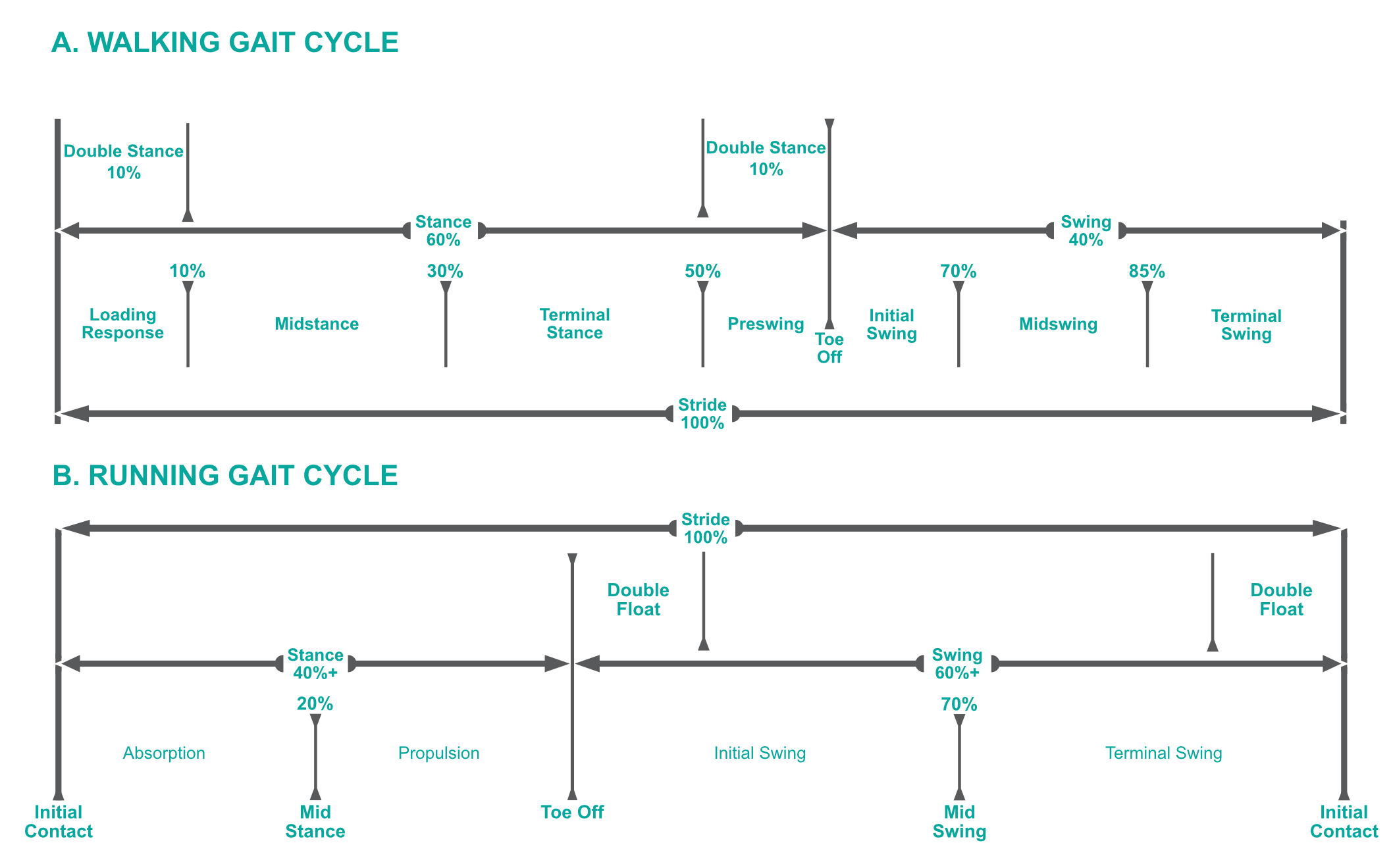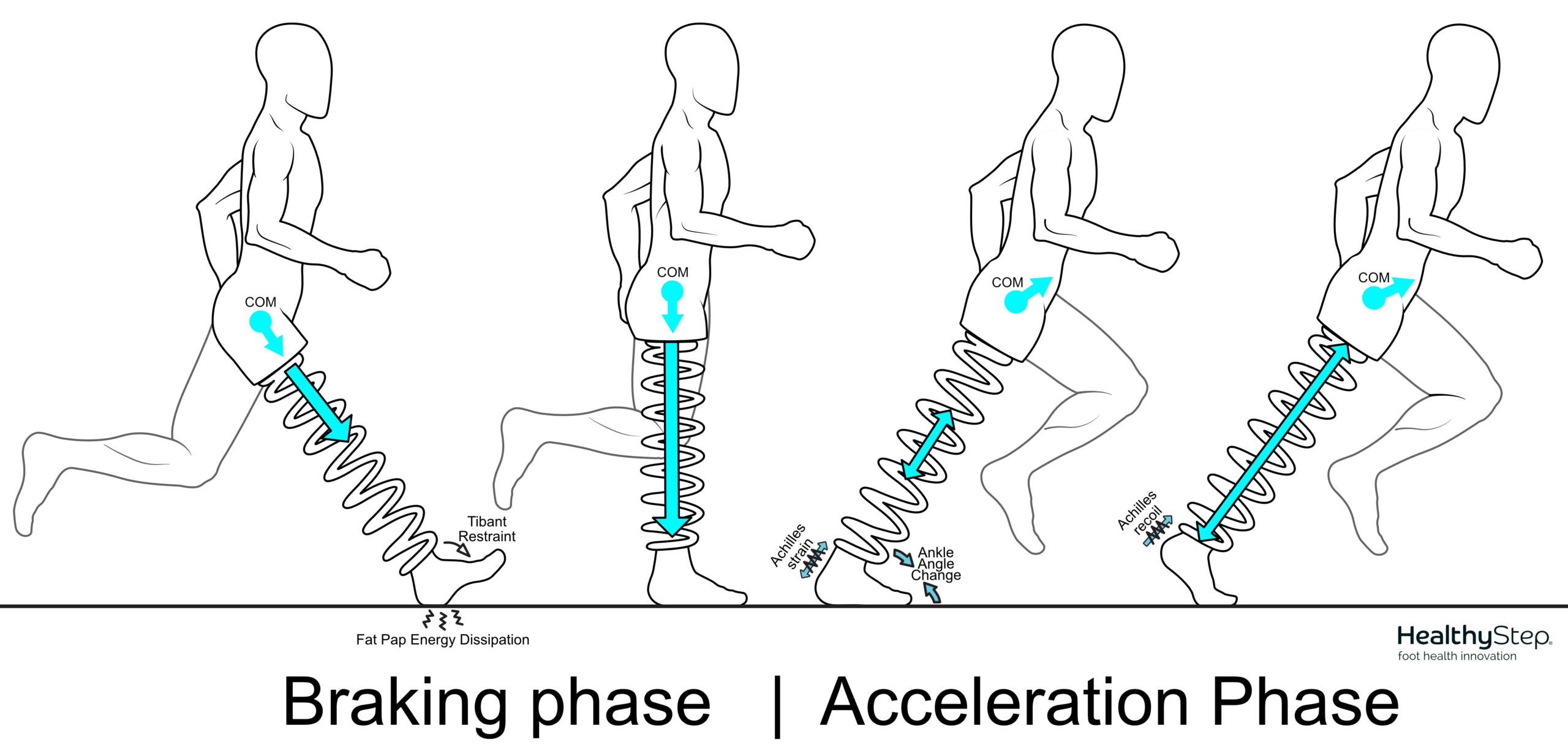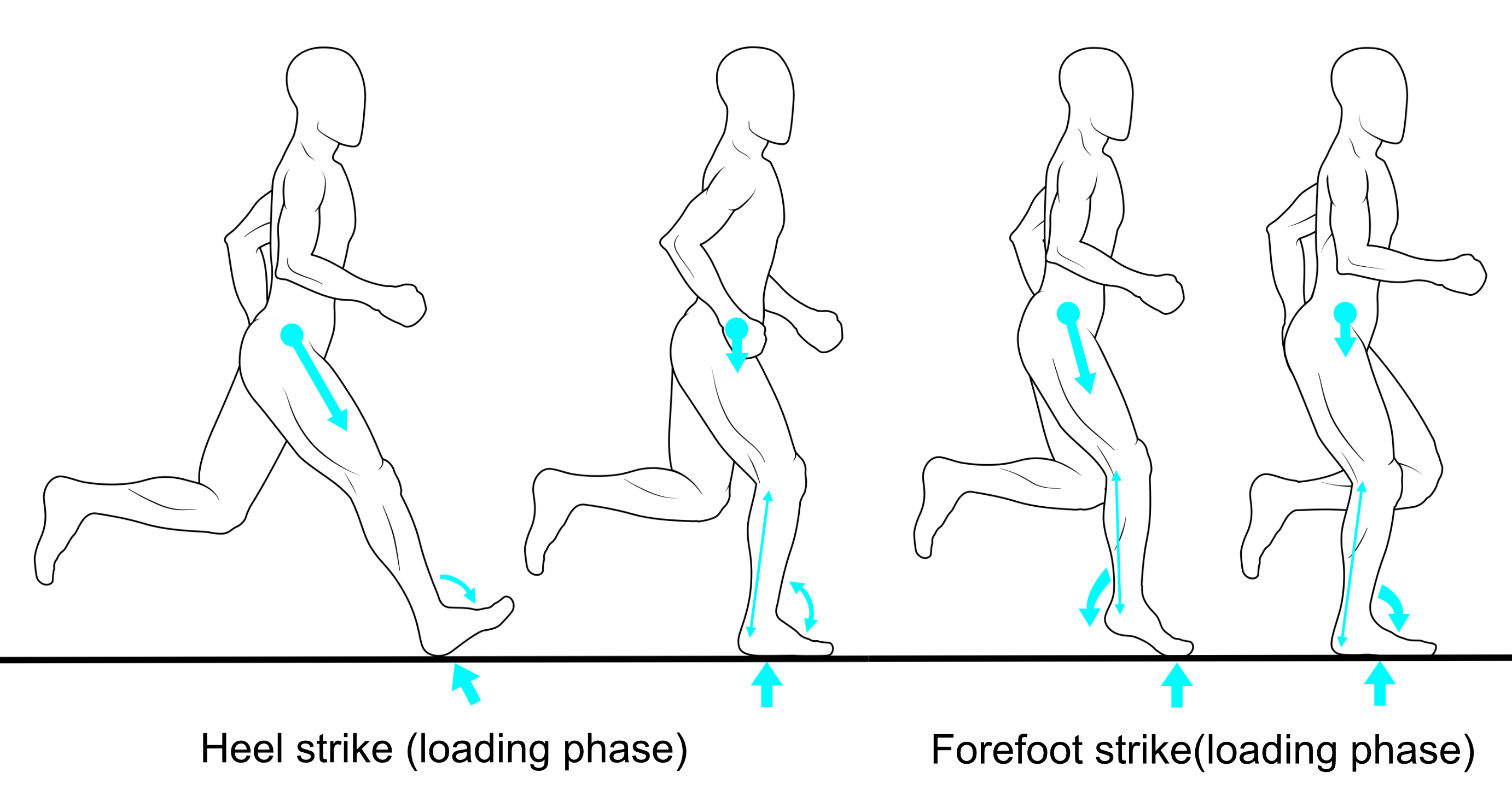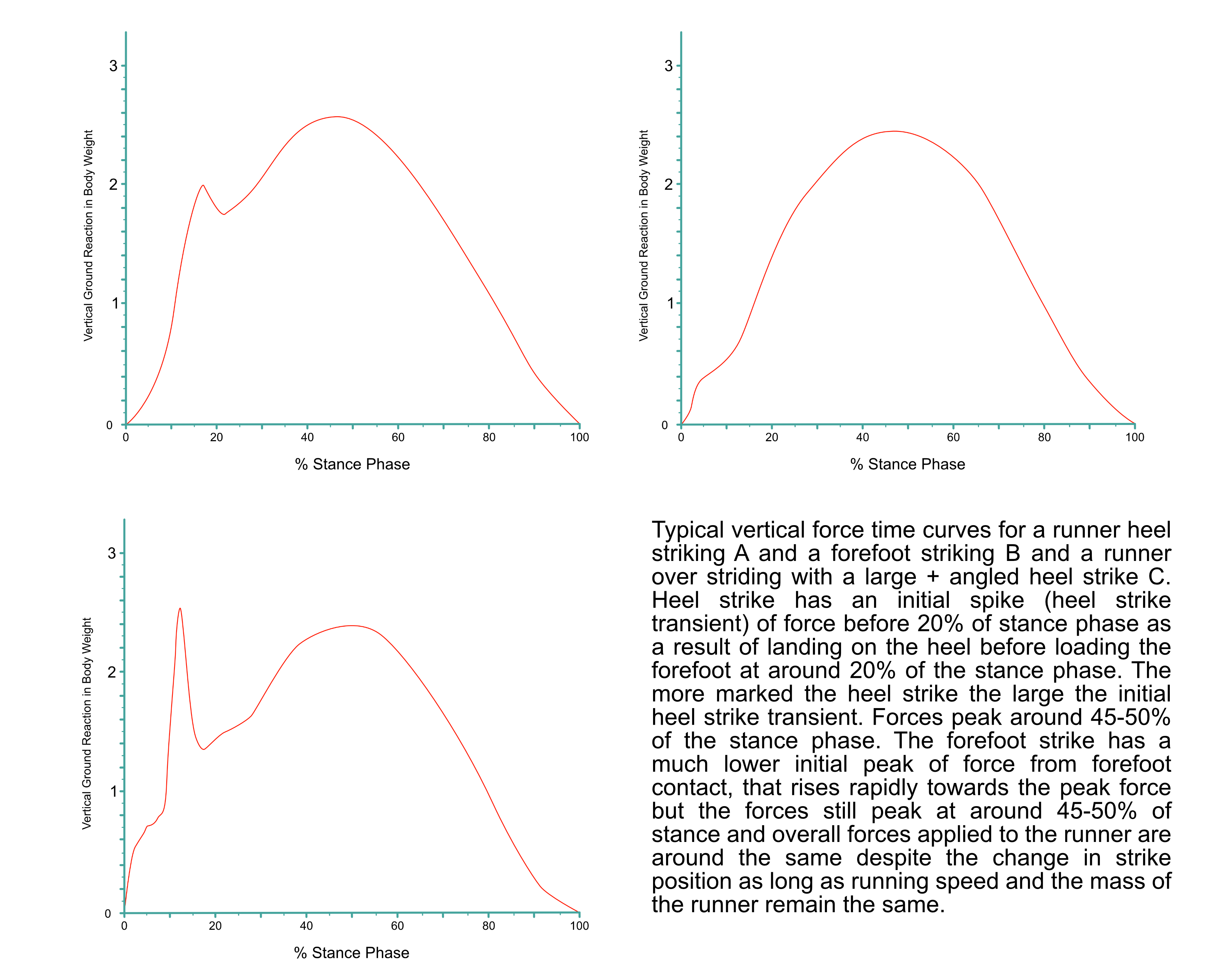Foot Strike Position & Their Effects in Running: Part 1
 Running, as opposed to walking, is the absence of a double limb stance period in gait (i.e. a float phase) and involves greater accelerations than occur during walking. The leading foot is completing its swing phase but is still swinging when the terminal stance phase completes and the foot leaves the ground on the trailing leg. How long the float phase lasts depends on running speed. The faster you run the longer the float phase and the shorter the stance phase of gait becomes, and the shorter a complete stride lasts.
Running, as opposed to walking, is the absence of a double limb stance period in gait (i.e. a float phase) and involves greater accelerations than occur during walking. The leading foot is completing its swing phase but is still swinging when the terminal stance phase completes and the foot leaves the ground on the trailing leg. How long the float phase lasts depends on running speed. The faster you run the longer the float phase and the shorter the stance phase of gait becomes, and the shorter a complete stride lasts.
Braking and acceleration uses energy!
Force is mass x acceleration, so the forces experienced in running are far greater than those that occur in walking. The forces relate to the energy being created in and by the body during running and just as in walking, we are either dissipating, storing, releasing or generating energy as we move. Humans dissipate energy by using special anatomy such as the heel fat pad, or through the action of muscle through a process called muscle-tendon buffering which allows joints and muscles to work together like shock absorbers.
Running involves much more energy than walking. The energetics or efficiency of human running is not good compared to the energetics of walking, being 50-80% greater in energy costs (1). This is because more braking and acceleration energy needs to be created by muscles during running than occur in walking (2,3). Running is based on a spring-mass system where we bounce onto and off of the ground, using spring-like behaviour to act as a shock absorber with the recoil from the energy stored in the spring to help to drive us upwards and forwards.
The human lower limb and foot works as an energy dissipator during the braking phase, taking some energy away from what can be stored during impact (4). The elastic recoil of the spring, therefore, needs extra muscle activity to make up the difference from that energy lost in braking, topping up the energy for the acceleration phase. The faster we run the worse the deficit between energy lost from braking to energy needed for acceleration (4). Therefore there is a burst of negative work during the collision (braking) event followed by a rebound from energy storage (5), supplemented by muscle activity to make up for the energy deficit (6). The result of this running energy-deficiency risks fatigue developing in the muscles far sooner and at a shorter distance than occurs in walking. Fatigue in running is a significant injury risk (7), so efficient running to prevent premature fatigue is important not only for performance but also to help prevent injury.
Foot Strike Position – Another Influence on Running Injury
Foot strike position affects which muscles are used in braking activity. The momentum arms of the joint directly influence how much activity muscles are required to generate and which muscles they should be.
The foot strike position is usually divided into four types, with forefoot running being suggested as the natural-evolved state when running without shoes (1). Running strikes have been classified as rearfoot, midfoot, forefoot and an extreme forefoot strike called “toe-running” (2). However, runner strike position sits on a continuum between the extremes of back-of-the-heel strike to toe-running (3), making strict classification and agreement on what positions one type of strike position actually is, difficult to quantitate (4). The more extreme heel-strikers or toe-runners are most likely to generate larger momentum arms for muscles to resist, because the force generated by impacting the ground (ground reaction force), usually ends up further away from a joint used for braking, and/or the weight of the body known as the centre of mass.
Heel-strikers tend to have the bodyweight further behind the foot contact than forefoot strikers, while forefoot strikers tend to occur with the bodyweight higher above the foot contact position. Heel strikers require the muscles at the front of the shin (tibialis anterior mainly) to brake the impact force slowing the forefoot to the floor, while forefoot strikers require the calf muscles through the Achilles tendon, to brake the heel descending to the floor. All running styles require hip and knee muscle braking, especially through the quadriceps and gluteus maximus, but the more the hip and knee flexion during the braking phase, the more energy these muscles must dissipate and store.
Speed is the greatest determinant of foot strike position, with faster running resulting in more forefoot runners, and more rearfoot strikers changing over to forefoot or midfoot (4, 5). These effects seem to be regardless of being barefoot and shod running (4, 5, 6) and occur without affecting contact time and stride length (2).
Runners have been told that developing forefoot or midfoot strike running can improve running efficiency, and can reduce impact and injury risk yet evidence does not seem to support this (7). When one considers that force is mass time acceleration the loading force at impact should be the same for a runner running at the same speed wearing the same shoes (or lack of), whatever the strike position because mass and acceleration remain the same. However, which muscles have to be used for braking, and which muscles get the bulk of the work will change.
Vertical Force Time Curves
The orthogonal direction or component (vertical, horizontal or transverse) of the force can change (through the angle of the ground reaction force vector) and this can change the direction and the length of the moment arms on the joints as well as the loading rate, but the total force the body generates with the ground remains the same. It is possible that the initial heel strike transient that appears so strikingly on a vertical force-time curve is the reason this statement is made. It is missing when there is no heel strike because it is produced by a heel strike event only. Forefoot strike positions do change peak loading rates (8,9) and hip adduction angle (10), but forefoot strikes increase the loading time of the Achilles tendon (11). Each strike position has its benefits and its problems.
So which is the best running strike position? The answer is there isn’t ‘the best one’ unless you define what you mean by ‘best’. Each running style will tend to increase loading on certain anatomical structures and decrease the load on others, so it depends on the runner’s injury.
The key points are:
- Strike position is not a direct result of shoes or barefoot running.
- Faster running produces more midfoot and forefoot strikes, but the change from one to the other is subject dependent.
- Forefoot running does not improve running economy.
- Forefoot running does not reduce impact forces but can slow peak loading rate.
- Shoes also delay peak loading rate.
- Forefoot running does not decrease injuries
- Different running styles are more likely to induce some injuries more than others.
- There is no BEST strike position for all runners!
In part 2 we will look at strike positions in detail and explain the benefits and disadvantages.
References
- Bramble DM, Libermann DE. (2004). Endurance running and the evolution of Homo. Nature. 432: 345-352.
- Nunns M, House C, Fallowfield J, Allsopp A, Dixon S. (2013). Biomechanical characteristics of barefoot foot strike modalities. J Biomech. 46: 2603-2610.
- Altman AR, Davis IS. ( 2012). A kinematic method for foot strike pattern detection in barefoot and shod runners. Gait & Posture. 35: 298-300.
- Forrester SE, Townend J. (2015).The effect of running velocity on foot strike angle-A curve-cluster approach. Gait & Posture. 41: 26-32.
- Hayes P, Caplin N (2012). Foot strike patterns ad ground contact times during high calibre middle-distance races. J Sports Sci. 30: 1275-83.
- Hasagawa H, Yamauchi T, Kraemer WJ.(2007). Footstrike patterns of runners at the 15-km point during elite half marathon. J Strength Cond. Res. 21: 888-93.
- Hamill J, Gruber AH. (2017). Is changing foot strike patterns beneficial to runners? J Sports Health Sci. 6: 146-53.
- Shih Y, Lin KL, Chiang TY, (2013). Is the foot strike pattern more important than barefoot or shod conditions in running? Gait & Posture. 38: 490-4.
- Boyer ER, Rooney BD, Derrick TR. (2014). Rearfoot and midfoot or forefoot impacts in habitually shod runners. Med. Sci. Sports Exerc. 46: 1384-91.
- Young JR, Silder A, Montgomery KL, et al. (2018). Acute changes in foot strike patterns and cadence affect running parameters associated with tibial stress fractures. J Biomech. 25: 1-7.
- Kernozek TW, Knaus A, Rademaker, et al, (2018). The effects of habitual foot strike patterns on Achilles tendon loading in female runners. Gait & Posture. 66: 283-7.



